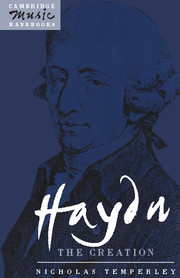Book contents
7 - Excerpts from critical essays
Published online by Cambridge University Press: 05 June 2012
Summary
Carl Friedrich Zelter (1802)
From a review of the published full score in the Allgemeine musikalische Zeitung 4 (1801–2), cols. 385–96, attributed to Zelter by H. C. Robbins Landon. The translation is mine.
The poem is a collection of pictures taken from the works of nature, and passes by like a succession of images, experienced and developed by means of skilful musicianship. The subject is the biblical account of the creation of the world: the poet dwells on the principal elements of the story from time to time, adding his own comments. In other words, the text is a description that is both narrative and poetic … To establish the necessary contrast, the poet has portrayed the absence of light and order as hostile forces, and has set against them the newly created light as a more powerful force. There is no place here for either persons or actions, and it is not clear why the poet has introduced the angels Raphael, Gabriel and Uriel to tell us the story of the creation as if they had been present. It is no excuse that these quite insignificant names lend plausibility to the variety of voices, for the poet could and should have represented the solo voices as he represents the chorus [that is, anonymously]. In short, so long as no character is revealed by actions and motivations, no person or name can be envisaged.
Information
- Type
- Chapter
- Information
- Haydn: The Creation , pp. 89 - 108Publisher: Cambridge University PressPrint publication year: 1991
